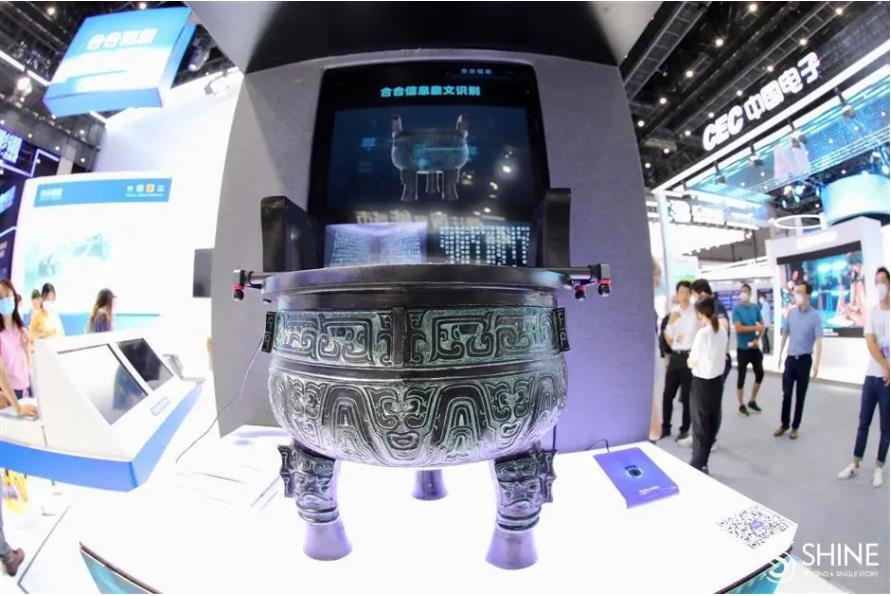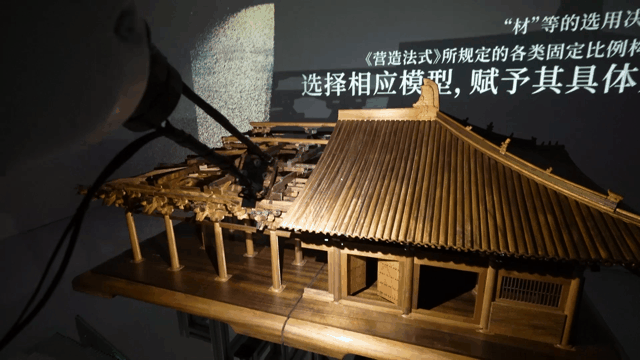政府新闻
中国传统文化与科技的完美结合 2022-09-12

A replica of an ancient China bronze tripod was displayed at WAIC. With a scanner and AI technology, the ancient China characters on the tripod can be recognized and translated for modern readers.
Artificial intelligence recognition of ancient Chinese characters on a bronze tripod; game and reality shops for Yangzhou's cosmetics; a tech-savvy exploration of a UNESCO heritage Foguang Temple to discover ancient China architectural secrets – advanced technology and innovations are being integrated with Chinese history and culture.
Those integrations are deepening thanks to the World Artificial Intelligence Conference or WAIC recently held in Shanghai, Shanghai Daily has learnt.
A replica of the Western Zhou's (1046-771 BC) bronze tripod was displayed at WAIC. With a scanner and AI technology, the ancient China characters on the tripod could be recognized and translated for modern readers.
The AI technology included advanced optical character recognition or OCR and natural language processing or NLP. Even in complicated conditions, such as darkness and trim edges, the characters can be automatically recognized, said the tech developer Shanghai-based Intsig.
The technology can be used in finance and law file organization, online learning, remote work and business card scanning, said Intsig.

New buildings and shops appear in game "100 Views of Jiangnan" to promote ancient Chinese cosmetic skills.
Also recently, new buildings including shops for rouge powder (脂粉), ancient Chinese cosmetic products, debuted in the game "100 Views of Jiangnan," a simulation game showing life and culture several hundred years ago in Jiangnan, or the lower reaches of Yangtze River Delta region.
With a digitalized in-game Yangzhou city, one of the most prosperous cities nationwide then, the game introduces ancient China cosmetics skills to gamers including many X generation players.
The game developer, Shanghai-based Coconut Island, joined with time-honored brand Xie Fuchun, which was founded in 1830. They want to promote themed products and culture both online and offline in an integrated marketing way.
A model of Foguang Temple, a Buddhist temple built in AD 857 in the Tang Dynasty (AD 618-907), was on show in WAIC's Xuhui exhibition hall.
With a history of 1,300 years, the UNESCO heritage temple still stands in Wutai Mountain in Shanxi Province now. It represents the "glory of ancient China architecture" because of its long existence as well as traditional and exquisite structures and techniques.

A tech-savvy way to explore an ancient China temple and traditional architecture.
At WAIC, SenseTime uses AI and augmented reality or AR technology to reconstruct it with a high-precision restoration in the virtual world.
The far-reaching and majestic bucket arches allow people to feel the magnificent Tang Dynasty's atmosphere. On the site, there is a robotic arm which recognizes a user's hand movements to go deep into the temple and explore its inner wood structure.
It's an impressive "metaverse-style" experience, especially when such a trip to the mountainous region is not easy with strict pandemic control measures, a SenseTime's booth visitor said.
As well as the integrations, those ancient China wisdoms are now used in high-tech firms, covering AI, cloud and payment sectors.
An ancient book Yingzao Fashi (营造法式), the oldest extant Chinese technical manual on architecture, records standard wooden building skills, was used in Foguang Temple and many later ancient China buildings. Inspired by the book, SenseTime launched its standardized AI manuals.
Xu Li, SenseTime's executive chairman, said the business was like Yingzao Fashi, forming an AI industry standard and manual to achieve highly scalable AI innovation.
It introduced four innovative AI platforms at WAIC, covering AI cloud computing, vehicle-road collaboration, AI in gaming and smart hospitals.

Artworks based on Dunhuang Grottoes art are shown at WAIC. Digital collection is a booming sector in China.
Liang Xingyuan, Huifu's chief architect, introduced the company's new Non-FungibleRights or NFR technology at WAIC.
The Shanghai-based Huifu aims to offer upgraded payment service for blockchain and metaverse sectors, which are used in copyright protection, brand value, user rights sectors in culture and tourism, fashion consumption, sports and digital collection sectors.
Huifu has named its product Dougong (斗拱), a bracketing system used in ancient Chinese buildings including Foguang Temple. Dougong services mean "customized, open and reliable" payment services today, Liang said.
Source: Shanghai Daily
